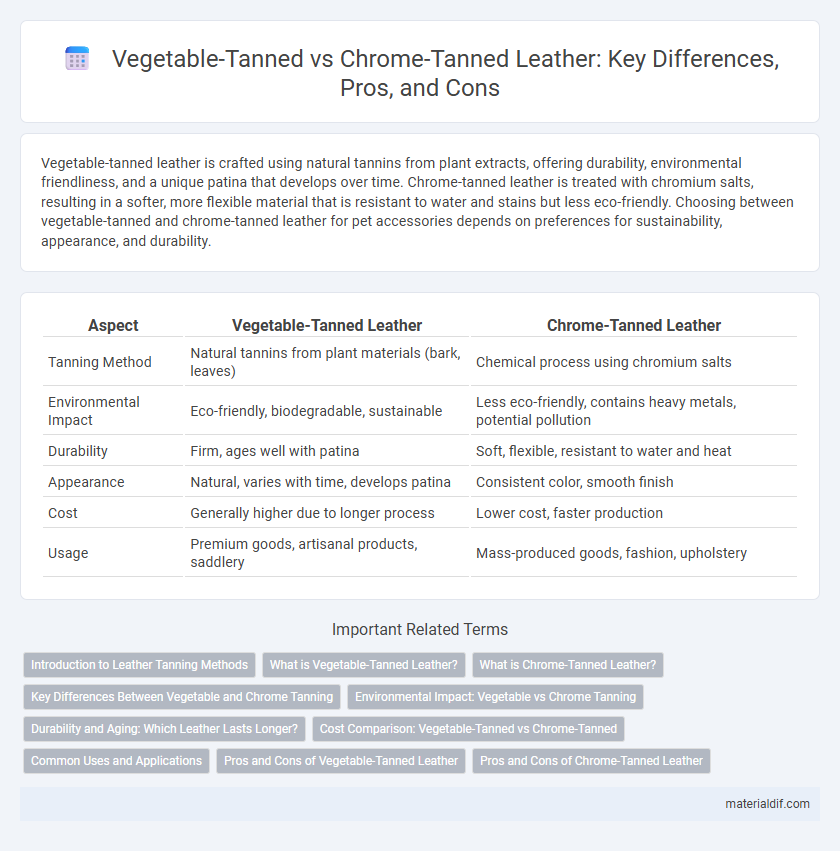Vegetable-tanned leather is crafted using natural tannins from plant extracts, offering durability, environmental friendliness, and a unique patina that develops over time. Chrome-tanned leather is treated with chromium salts, resulting in a softer, more flexible material that is resistant to water and stains but less eco-friendly. Choosing between vegetable-tanned and chrome-tanned leather for pet accessories depends on preferences for sustainability, appearance, and durability.
Table of Comparison
| Aspect | Vegetable-Tanned Leather | Chrome-Tanned Leather |
|---|---|---|
| Tanning Method | Natural tannins from plant materials (bark, leaves) | Chemical process using chromium salts |
| Environmental Impact | Eco-friendly, biodegradable, sustainable | Less eco-friendly, contains heavy metals, potential pollution |
| Durability | Firm, ages well with patina | Soft, flexible, resistant to water and heat |
| Appearance | Natural, varies with time, develops patina | Consistent color, smooth finish |
| Cost | Generally higher due to longer process | Lower cost, faster production |
| Usage | Premium goods, artisanal products, saddlery | Mass-produced goods, fashion, upholstery |
Introduction to Leather Tanning Methods
Vegetable-tanned leather is produced using natural tannins extracted from tree bark, leaves, and fruits, creating a durable, eco-friendly material ideal for artisanal crafts and long-lasting goods. Chrome-tanned leather, treated with chromium salts, offers enhanced softness, water resistance, and faster production times, making it popular in mass-produced leather products. Each tanning method affects the leather's texture, color, and environmental impact, influencing its suitability for different applications and consumer preferences.
What is Vegetable-Tanned Leather?
Vegetable-tanned leather is crafted using natural tannins extracted from tree bark, leaves, and other plant materials, resulting in a durable, eco-friendly hide that develops a unique patina over time. This tanning method avoids heavy metals like chromium, making the leather biodegradable and more sustainable compared to chrome-tanned alternatives. Vegetable-tanned leather is prized for its firmness and ability to mold with use, commonly used in high-quality saddlery, belts, and artisanal leather goods.
What is Chrome-Tanned Leather?
Chrome-tanned leather is processed using chromium salts, primarily chromium sulfate, which allows for faster tanning compared to vegetable tanning. This method produces leather with enhanced softness, flexibility, and water resistance, making it ideal for fashion, upholstery, and accessories. The chromium tanning process also provides superior durability and color retention, distinguishing it from the more natural and eco-friendly vegetable tanning technique.
Key Differences Between Vegetable and Chrome Tanning
Vegetable tanning uses natural tannins from tree bark and leaves, resulting in leather that is firmer, more durable, and develops a rich patina over time, making it eco-friendly but requiring longer processing. Chrome tanning involves chromium salts, producing softer, more water-resistant leather with greater color consistency and faster production, though it is less environmentally sustainable. The primary differences lie in the tanning agents used, environmental impact, leather texture, durability, and processing time.
Environmental Impact: Vegetable vs Chrome Tanning
Vegetable tanning uses natural tannins from tree bark and plants, resulting in biodegradable leather with minimal chemical pollution and lower water consumption. Chrome tanning relies on chromium salts that can release hazardous waste, posing significant risks to soil and water quality if not properly managed. Choosing vegetable-tanned leather supports sustainable practices by reducing toxic emissions and promoting eco-friendly waste treatment.
Durability and Aging: Which Leather Lasts Longer?
Vegetable-tanned leather offers exceptional durability due to its dense, natural fibers, making it highly resistant to wear and tear over time. It develops a rich patina with age, enhancing both its aesthetic appeal and longevity. Chrome-tanned leather, while generally softer and more flexible, tends to degrade faster under prolonged exposure to heat and moisture, resulting in shorter lifespan compared to vegetable-tanned options.
Cost Comparison: Vegetable-Tanned vs Chrome-Tanned
Vegetable-tanned leather generally incurs higher initial costs due to its labor-intensive tanning process and longer production time compared to chrome-tanned leather, which benefits from faster chemical tanning methods and lower material expenses. The durability and aging characteristics of vegetable-tanned leather often justify its premium price for high-quality, artisanal goods, while chrome-tanned leather appeals to budget-conscious markets with its cost efficiency and quicker manufacturing. Understanding these cost dynamics helps manufacturers and consumers make informed choices based on budget constraints and product longevity preferences.
Common Uses and Applications
Vegetable-tanned leather is commonly used in high-quality leather goods like belts, wallets, and saddlery due to its durability and ability to develop a rich patina over time. Chrome-tanned leather is preferred for fashion accessories, upholstery, and footwear because of its softness, flexibility, and resistance to water and heat. Both tanning methods offer distinct advantages, with vegetable tanning favored in artisanal and luxury products, while chrome tanning dominates mass-produced leather goods.
Pros and Cons of Vegetable-Tanned Leather
Vegetable-tanned leather is prized for its natural, eco-friendly tanning process using tannins from tree bark and plants, resulting in a durable, biodegradable product with rich patina development over time. It tends to be stiffer and less water-resistant compared to chrome-tanned leather, making it less suitable for products exposed to high moisture or requiring softness. Despite higher costs and longer production times, vegetable-tanned leather offers superior aging qualities and environmental benefits, appealing to artisanal goods and sustainable fashion markets.
Pros and Cons of Chrome-Tanned Leather
Chrome-tanned leather offers superior durability, flexibility, and water resistance due to the use of chromium salts in the tanning process, making it ideal for products exposed to moisture and heavy use. However, this tanning method involves chemicals that can pose environmental and health concerns if not managed properly, and the leather may lack the rich, natural patina that vegetable-tanned leather develops over time. Chrome-tanned leather also tends to be more cost-effective and produces consistent color and texture, appealing to mass-market manufacturers.
Vegetable-tanned vs Chrome-tanned Infographic

 materialdif.com
materialdif.com